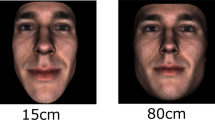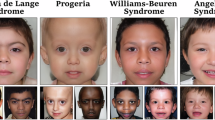Abstract
An increasing number of genetic syndromes present a challenge to clinical geneticists. A deep learning-based diagnosis assistance system, Face2Gene, utilizes the aggregation of “gestalt,” comprising data summarizing features of patients’ facial images, to suggest candidate syndromes. Because Face2Gene’s results may be affected by ethnicity and age at which training facial images were taken, the system performance for patients in Japan is still unclear. Here, we present an evaluation of Face2Gene using the following two patient groups recruited in Japan: Group 1 consisting of 74 patients with 47 congenital dysmorphic syndromes, and Group 2 consisting of 34 patients with Down syndrome. In Group 1, facial recognition failed for 4 of 74 patients, while 13–21 of 70 patients had a diagnosis for which Face2Gene had not been trained. Omitting these 21 patients, for 85.7% (42/49) of the remainder, the correct syndrome was identified within the top 10 suggested list. In Group 2, for the youngest facial images taken for each of the 34 patients, Down syndrome was successfully identified as the highest-ranking condition using images taken from newborns to those aged 25 years. For the oldest facial images taken at ≥20 years in each of 17 applicable patients, Down syndrome was successfully identified as the highest- and second-highest-ranking condition in 82.2% (14/17) and 100% (17/17) of the patients using images taken from 20 to 40 years. These results suggest that Face2Gene in its current format is already useful in suggesting candidate syndromes to clinical geneticists, using patients with congenital dysmorphic syndromes in Japan.
Similar content being viewed by others
Log in or create a free account to read this content
Gain free access to this article, as well as selected content from this journal and more on nature.com
or
References
Kikuiri T, Mishima H, Imura H, Suzuki S, Matsuzawa Y, Nakamura T, et al. Patients with SATB2-associated syndrome exhibiting multiple odontomas. Am J Med Genet A. 2018;176A:2614–22.
Groza T, Köhler S, Moldenhauer D, Vasilevsky N, Baynam G, Zemojtel T, et al. The human phenotype ontology: semantic unification of common and rare disease. Am J Hum Genet. 2015;97:111–24.
Smedley D, Jacobsen JOB, Jäger M, Köhler S, Holtgrewe M, Schubach M, et al. Next-generation diagnostics and disease-gene discovery with the Exomiser. Nat Protoc. 2015;10:2004–15.
Fujiwara T, Yamamoto Y, Kim J-D, Buske O, Takagi T. PubCaseFinder: a case-report-based, phenotype-driven differential-diagnosis system for rare diseases. Am J Hum Genet. 2018;103:389–99.
Gripp KW, Baker L, Telegrafi A, Monaghan KG. The role of objective facial analysis using FDNA in making diagnoses following whole exome analysis. Report of two patients with mutations in the BAF complex genes. Am J Med Genet A. 2016;170:1754–62.
Gurovich Y, Hanani Y, Bar O, Nadav G, Fleischer N, Gelbman D, et al. Identifying facial phenotypes of genetic disorders using deep learning. Nat Med. 2019;25:60.
Basel‐Vanagaite L, Wolf L, Orin M, Larizza L, Gervasini C, Krantz ID, et al. Recognition of the Cornelia de Lange syndrome phenotype with facial dysmorphology novel analysis. Clin Genet. 2016;89:557–63.
Valentine M, Bihm DCJ, Wolf L, Hoyme HE, May PA, Buckley D, et al. Computer-aided recognition of facial attributes for fetal alcohol spectrum disorders. Pediatrics. 2017;140:e20162028.
Pantel JT, Zhao M, Mensah MA, Hajjir N, Hsieh T-C, Hanani Y, et al. Advances in computer-assisted syndrome recognition by the example of inborn errors of metabolism. J Inherit Metab Dis. 2018;41:533–9.
Zarate YA, Smith-Hicks CL, Greene C, Abbott M-A, Siu VM, Calhoun ARUL. et al. Natural history and genotype-phenotype correlations in 72 individuals with SATB2-associated syndrome. Am J Med Genet A. 2018;176:925–35.
Liehr T, Acquarola N, Pyle K, St‐Pierre S, Rinholm M, Bar O, et al. Next generation phenotyping in Emanuel and Pallister–Killian syndrome using computer-aided facial dysmorphology analysis of 2D photos. Clin Genet. 2018;93:378–81.
Amudhavalli SM, Hanson R, Angle B, Bontempo K, Gripp KW. Further delineation of Aymé-Gripp syndrome and use of automated facial analysis tool. Am J Med Genet A. 2018;176:1648–56.
Knaus A, Pantel JT, Pendziwiat M, Hajjir N, Zhao M, Hsieh T-C, et al. Characterization of glycosylphosphatidylinositol biosynthesis defects by clinical features, flow cytometry, and automated image analysis. Genome Med. 2018;10:3.
Martinez-Monseny A, Cuadras D, Bolasell M, Muchart J, Arjona C, Borregan M, et al. From gestalt to gene: early predictive dysmorphic features of PMM2-CDG. J Med Genet. 2018;56:236–45. Epub ahead of print
Lumaka A, Cosemans N, Lulebo Mampasi A, Mubungu G, Mvuama N, Lubala T, et al. Facial dysmorphism is influenced by ethnic background of the patient and of the evaluator. Clin Genet. 2017;92:166–71.
Vorravanpreecha N, Lertboonnum T, Rodjanadit R, Sriplienchan P, Rojnueangnit K. Studying down syndrome recognition probabilities in Thai children with de-identified computer-aided facial analysis. Am J Med Genet A. 2018;176:1935–40.
Stewart DR, Pemov A, Johnston JJ, Sapp JC, Yeager M, He J, et al. Dubowitz syndrome is a complex comprised of multiple, genetically distinct and phenotypically overlapping disorders. PLOS One. 2014;9:e98686.
Millan F, Cho MT, Retterer K, Monaghan KG, Bai R, Vitazka P, et al. Whole exome sequencing reveals de novo pathogenic variants in KAT6A as a cause of a neurodevelopmental disorder. Am J Med Genet A. 2016;170:1791–8.
Acknowledgements
We thank Bambi-no-kai, the supporting organization for individuals with chromosomal disabilities, for public relations help regarding research participation in Group 2. We also thank Edanz (www.edanzediting.co.jp) for editing the English text of a draft of this manuscript. This study was supported by JSPS KAKENHI Grant Number JP18K07850 and by AMED under Grant Number JP19kk0205014, JP19ek0109234, and JP19ek0109301.
Author information
Authors and Affiliations
Corresponding author
Ethics declarations
Conflict of interest
The authors declare that they have no conflict of interest.
Additional information
Publisher’s note: Springer Nature remains neutral with regard to jurisdictional claims in published maps and institutional affiliations.
Supplementary information
Rights and permissions
About this article
Cite this article
Mishima, H., Suzuki, H., Doi, M. et al. Evaluation of Face2Gene using facial images of patients with congenital dysmorphic syndromes recruited in Japan. J Hum Genet 64, 789–794 (2019). https://doi.org/10.1038/s10038-019-0619-z
Received:
Revised:
Accepted:
Published:
Issue date:
DOI: https://doi.org/10.1038/s10038-019-0619-z
This article is cited by
-
The application of the facial analysis program Face2Gene in a single genetic counseling center: a retrospective study
Egyptian Pediatric Association Gazette (2025)
-
Identification of intragenic variants in pediatric patients with intellectual disability in Peru
BMC Medical Genomics (2025)
-
Workflow analysis and evaluation of a next-generation phenotyping tool: A qualitative study of Face2Gene
European Journal of Human Genetics (2025)
-
A cost-efficient algorithm for diagnosing children with dysmorphic features
Egyptian Journal of Medical Human Genetics (2024)
-
Optimization and evaluation of facial recognition models for Williams-Beuren syndrome
European Journal of Pediatrics (2024)



